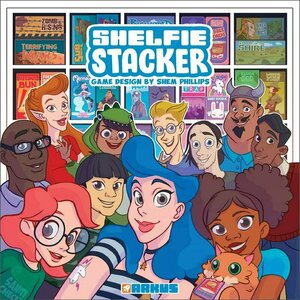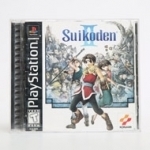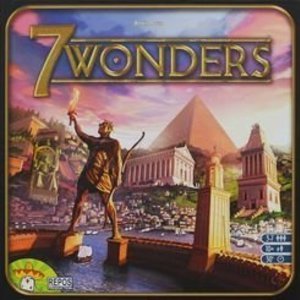Search
Search results
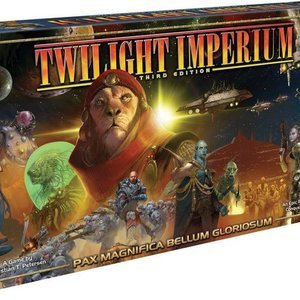
Twilight Imperium Third Edition
Tabletop Game
Twilight Imperium Third Edition is an epic empire-building game of interstellar conflict, trade, and...

Plague Inc.: The Board Game
Tabletop Game
Plague Inc: The Board Game is a strategic game of infection, evolution and extinction for 1-5*...

Black Rose Wars: Rebirth
Tabletop Game
Black Rose Wars: Rebirth is a competitive fantasy game of deck-building, strategy, and combat set in...
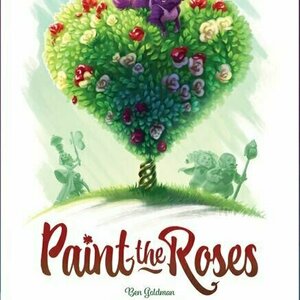
Paint the Roses
Tabletop Game
Paint the Roses is a 2-5 player cooperative logic deduction game that automatically adapts to your...
Purple Phoenix Games (2266 KP) rated Shelfie Stacker in Tabletop Games
Jul 29, 2021
I don’t know about you, but I love getting a new game. Unboxing it, punching tokens, reading the rules – it’s so satisfying! Now after that fun is done comes my dilemma: where to put it on my shelves… I know I’m not the only one that runs into this problem. I often see on Board Gamer Facebook groups queries about how to store/organize games. Do you place them vertically or horizontally? Organize by publisher? Size of box? Box color? Player counts? The list is nearly endless. So Arkus Games had the brilliant idea to make a meta-game in which you must sort and organize your game shelf! After having a good laugh at this theme and game, I decided to back it on Kickstarter. And as you can see above, it is one that has earned The Golden Feather Award for us!
Disclaimer: I do not intend to rehash the entire rulebook in this review, but rather provide an overview of the rules and gameplay. For a more in-depth look, check out the game at your FLGS or directly from the publisher. -L
Shelfie Stacker is a game of dice drafting and hand management in which players are trying to create the most prestigious board game shelf in the group. Players will be drafting dice, manipulating them with special abilities, and placing them on their Big Shelf in an effort to amass the most points by the end of 7 rounds. To setup for the game, each player receives a Big Shelf, Shelf of Shame, and Character Cards in their chosen color. Of the 16 Character Cards, you will select 8 with which to play this game, and return the others to the box. Place the Delivery Boxes in the center of the table (1 per player, plus 1 more), and place the dice into the dice bag. Randomly select 1 Sidekick, First to Claim, and End of Game cards and place them face-up in view of all players. The game is now ready to begin!
The game is played over a series of 7 rounds, each broken down into 5 phases. The first phase is to fill the Delivery Boxes. To do so, one player will draw and place 3 dice from the dice bag onto each Delivery Box. The dice don’t need to be rolled, but the drawing player shouldn’t change the faces in any way when placing. In the next phase, all players will select a Character Card to play. This will determine the turn order for the round. The Character Cards are numbered 1-16 (you only use 8 total cards in a game though), and each provide a special one-time ability for use in the game. Players select their Character Card in secret, and then will simultaneously reveal them. Starting with the player who played the lowest-value Character Card, each player will select one of the available Delivery Boxes as their own.
Once you have a Delivery Box, you will then start placing the dice in your Big Shelf! You must place all of your dice, following the placement rules (detailed in the rulebook). During this phase of the round is when most Character Card abilities will be used. These are one-time abilities to be used throughout the game, and allow you to manipulate your dice in various ways. One super important note is that the Character abilities do not need to be used on the same round in which they are played! So I could play a card for its number value (securing my spot in the turn order), but not use its ability until a later round. This really gives you the opportunity to strategize and potentially chain abilities together for maximum results! Once an ability has been used, it is discarded from the game and cannot be used again.
At any point during a round, a player may be able to claim the First to Claim or Sidekick cards, which provide end-game points. The first player to create the depicted pattern on the First to Claim card takes and keeps it for the end of the game. The Sidekick, however, won’t necessarily remain with one player. For example, I may have the most blue dice now and claim the Sidekick, but if in a later round you have more blue dice than me, you can steal it from me! If you are unable to place any/all of your dice on your Big Shelf. they will be placed on your Shelf of Shame *womp womp* and any dice there earn negative points in final scoring. When everyone has finished placing their dice, you prepare for the next round. The Delivery Boxes are returned to the center, and the game is ready to move to the next round.
After the 7th round, the game ends and final scoring takes place. Players can earn points in several ways: if columns get to a certain height, points per pip on the highest die of each column, bonus cards (First to Claim, Sidekick, and End of Game), and you lose 2 points for every die in your Shelf of Shame. Points are totaled and the player with the highest score is the winner!
Putting aside the humor and the theme, Shelfie Stacker is actually a very solid game. The premise is simple (manipulate and place dice) but the actual execution is more strategic than I first thought. The placement rules alone create quite a challenge. The first couple of rounds really determine your success in later rounds. If you don’t set yourself up early in the game with a good strategy, it could all come crashing down as the game progresses. Couple that with the Character Card abilities, and the strategy is elevated once more. You have to decide when to use which abilities, knowing that they are a one-time use. One of my favorite parts of this game is the fact that abilities do not have to be used immediately when played. So maybe I want to go early in the round so I play a low-value card. I can hang onto that special ability until I am ready to play it – I am not forced to use it until I decide to. This adds to the strategy because it allows you to choose when to use cards for maximum benefit, potentially even using multiple abilities in a row to get the desired result. Be warned though, this game could be a little AP-inducing as it gets into later rounds and you have to be more focused with your strategy. Not that the game necessarily halts altogether, but be ready for a little downtime as all players consider their options at the top of a round.
The components of Shelfie Stacker are excellent. The Big Shelf and Shelf of Shame boards are nice and thick dual-layered cardboard that really keep the dice in place. The dice themselves are fun colors, clear to read, and easy to manipulate. The artwork on all the cards is unique and fun, and the rulebook is clear and concise. So all in all, Shelfie Stacker gets an A+ from me with regards to production quality.
Obviously, as you saw in my graphic at the top of this review, Shelfie Stacker gets nothing but praise from me. The theme might not be one that appeals to everyone (especially non-gamers), but the gameplay is super solid and engaging. Every game is unique and strategically challenging, and it really puts you to the test mentally. If you’re in the market for something with a light and fun theme, but that really packs a punch with serious gameplay, I would highly recommend Shelfie Stacker. Then, of course, when you get it you have to decide where to put it on your shelf. The eternal struggle of gamers! Purple Phoenix Games awards this one the coveted Golden Feather Award! That’s right – I think this is a contender for my Top 10! Ooh, what if I put my Top 10 all together on my shelf……
Disclaimer: I do not intend to rehash the entire rulebook in this review, but rather provide an overview of the rules and gameplay. For a more in-depth look, check out the game at your FLGS or directly from the publisher. -L
Shelfie Stacker is a game of dice drafting and hand management in which players are trying to create the most prestigious board game shelf in the group. Players will be drafting dice, manipulating them with special abilities, and placing them on their Big Shelf in an effort to amass the most points by the end of 7 rounds. To setup for the game, each player receives a Big Shelf, Shelf of Shame, and Character Cards in their chosen color. Of the 16 Character Cards, you will select 8 with which to play this game, and return the others to the box. Place the Delivery Boxes in the center of the table (1 per player, plus 1 more), and place the dice into the dice bag. Randomly select 1 Sidekick, First to Claim, and End of Game cards and place them face-up in view of all players. The game is now ready to begin!
The game is played over a series of 7 rounds, each broken down into 5 phases. The first phase is to fill the Delivery Boxes. To do so, one player will draw and place 3 dice from the dice bag onto each Delivery Box. The dice don’t need to be rolled, but the drawing player shouldn’t change the faces in any way when placing. In the next phase, all players will select a Character Card to play. This will determine the turn order for the round. The Character Cards are numbered 1-16 (you only use 8 total cards in a game though), and each provide a special one-time ability for use in the game. Players select their Character Card in secret, and then will simultaneously reveal them. Starting with the player who played the lowest-value Character Card, each player will select one of the available Delivery Boxes as their own.
Once you have a Delivery Box, you will then start placing the dice in your Big Shelf! You must place all of your dice, following the placement rules (detailed in the rulebook). During this phase of the round is when most Character Card abilities will be used. These are one-time abilities to be used throughout the game, and allow you to manipulate your dice in various ways. One super important note is that the Character abilities do not need to be used on the same round in which they are played! So I could play a card for its number value (securing my spot in the turn order), but not use its ability until a later round. This really gives you the opportunity to strategize and potentially chain abilities together for maximum results! Once an ability has been used, it is discarded from the game and cannot be used again.
At any point during a round, a player may be able to claim the First to Claim or Sidekick cards, which provide end-game points. The first player to create the depicted pattern on the First to Claim card takes and keeps it for the end of the game. The Sidekick, however, won’t necessarily remain with one player. For example, I may have the most blue dice now and claim the Sidekick, but if in a later round you have more blue dice than me, you can steal it from me! If you are unable to place any/all of your dice on your Big Shelf. they will be placed on your Shelf of Shame *womp womp* and any dice there earn negative points in final scoring. When everyone has finished placing their dice, you prepare for the next round. The Delivery Boxes are returned to the center, and the game is ready to move to the next round.
After the 7th round, the game ends and final scoring takes place. Players can earn points in several ways: if columns get to a certain height, points per pip on the highest die of each column, bonus cards (First to Claim, Sidekick, and End of Game), and you lose 2 points for every die in your Shelf of Shame. Points are totaled and the player with the highest score is the winner!
Putting aside the humor and the theme, Shelfie Stacker is actually a very solid game. The premise is simple (manipulate and place dice) but the actual execution is more strategic than I first thought. The placement rules alone create quite a challenge. The first couple of rounds really determine your success in later rounds. If you don’t set yourself up early in the game with a good strategy, it could all come crashing down as the game progresses. Couple that with the Character Card abilities, and the strategy is elevated once more. You have to decide when to use which abilities, knowing that they are a one-time use. One of my favorite parts of this game is the fact that abilities do not have to be used immediately when played. So maybe I want to go early in the round so I play a low-value card. I can hang onto that special ability until I am ready to play it – I am not forced to use it until I decide to. This adds to the strategy because it allows you to choose when to use cards for maximum benefit, potentially even using multiple abilities in a row to get the desired result. Be warned though, this game could be a little AP-inducing as it gets into later rounds and you have to be more focused with your strategy. Not that the game necessarily halts altogether, but be ready for a little downtime as all players consider their options at the top of a round.
The components of Shelfie Stacker are excellent. The Big Shelf and Shelf of Shame boards are nice and thick dual-layered cardboard that really keep the dice in place. The dice themselves are fun colors, clear to read, and easy to manipulate. The artwork on all the cards is unique and fun, and the rulebook is clear and concise. So all in all, Shelfie Stacker gets an A+ from me with regards to production quality.
Obviously, as you saw in my graphic at the top of this review, Shelfie Stacker gets nothing but praise from me. The theme might not be one that appeals to everyone (especially non-gamers), but the gameplay is super solid and engaging. Every game is unique and strategically challenging, and it really puts you to the test mentally. If you’re in the market for something with a light and fun theme, but that really packs a punch with serious gameplay, I would highly recommend Shelfie Stacker. Then, of course, when you get it you have to decide where to put it on your shelf. The eternal struggle of gamers! Purple Phoenix Games awards this one the coveted Golden Feather Award! That’s right – I think this is a contender for my Top 10! Ooh, what if I put my Top 10 all together on my shelf……
Lou Grande (148 KP) rated Suikoden II in Video Games
May 12, 2018
108 Characters (4 more)
Expanded World
Multiple Endings
Sidequests
Great Music
Favorite Game - Hands Down
Like the first game, Suikoden II centers on a young man who is pulled into a war between nations. Once again, you must collect the 108 Stars of Destiny, and your success determines how the story ends. Several characters from Suikoden I appear here, as the story is only set a few years after. I love everything about this game, down to the sprites. Although it follows the same basic formula as the first, it improves on it in almost every way. The music is better, the battle system is better, and the plot is much more far-reaching and ambitious--and heartbreaking, depending on how you play your cards. Luca Blight is a terrifyingly human villain. It's a pity this game was so rare in its day.
Glen Banyard (13 KP) rated Pokémon: Detective Pikachu (2019) in Movies
May 12, 2019
Predictable plot (1 more)
Forced humour
Pika Pika
Pokemon is a global brand spanning cartoon, cards, animated films, video games and now a live film, well as live as you can get with imaginary creatures.
Watched in 3D, it really didn't bring anything extra to film.
The plot is pretty much by the numbers and suffers from being horribly predictable, this most likely due to being aimed at a much younger demographic. Bill Nighy really got license to over act his heart out and it shows, in his somewhat limited screen time.
Will it spawn a sequel, possibly, only time will tell as it's launched at difficult time with Endgame still massing larger viewings and Aladdin and John Wick 3 releasing in the next 10 days, it may get squashed to limited performances quickly.
Watched in 3D, it really didn't bring anything extra to film.
The plot is pretty much by the numbers and suffers from being horribly predictable, this most likely due to being aimed at a much younger demographic. Bill Nighy really got license to over act his heart out and it shows, in his somewhat limited screen time.
Will it spawn a sequel, possibly, only time will tell as it's launched at difficult time with Endgame still massing larger viewings and Aladdin and John Wick 3 releasing in the next 10 days, it may get squashed to limited performances quickly.
Red Otter (340 KP) rated Arboretum in Tabletop Games
Jun 4, 2019
Arboretum seems like a peaceful game of planting trees, but at its heart, it's a brutal game of hard choices. Every turn, you draw 2 cards, play a card from your hand, and discard one card for anyone to take. As you make paths of trees and plan out how you'll proceed, you always have to keep in mind the unique scoring system of the game. At the end of the game, whoever has the most points of a particular tree left in their hand, scores. It forces you to be careful in how much you commit to a particular tree, while still trying to outscore other people and keep them for scoring. I love this game as every decision in what you discard matters. It plays very well at two, and I look forward to playing at other counts.
Red Otter (340 KP) rated 7 Wonders in Tabletop Games
Jun 7, 2019
7 Wonders is one of my go-to games for larger groups. Capable of handling up to 7 players, it's both strategic and a good casual game. As the game that brought drafting as the primary game mechanic into the forefront of tabletop gaming, it still remains on the top of the list. It does take a game for a new player to understand what they need to prioritize and need to keep an eye out of cards, but once they make it through a round, they'll be enjoying it in no time. Quick gameplay with lots of decision space allows for a fulfilling game that you can look back on and realize oh I should have done this!. There are issues with a lack of player interaction with people not next to you, but expansions do offer solutions to that.

